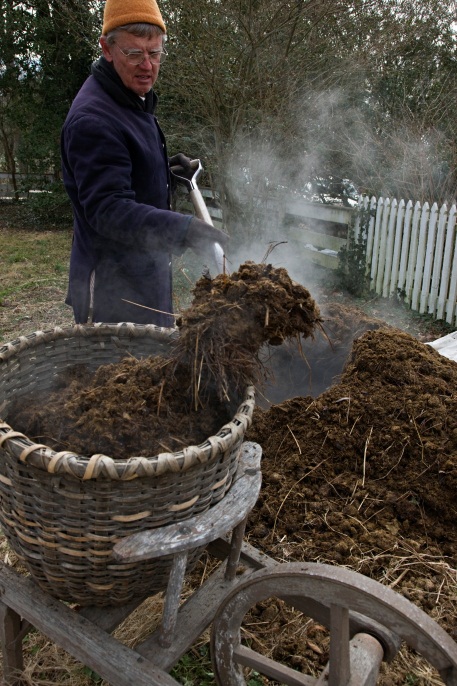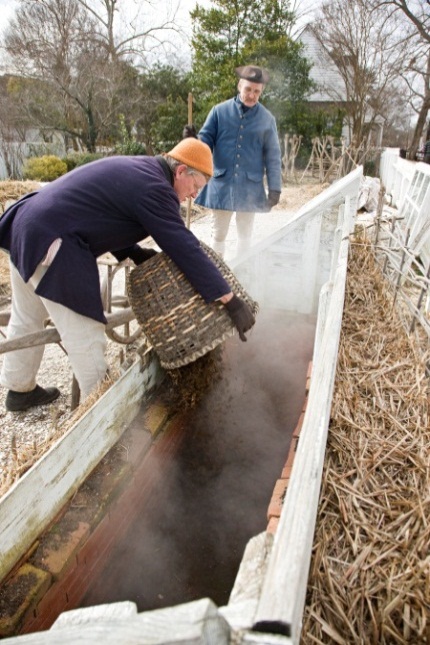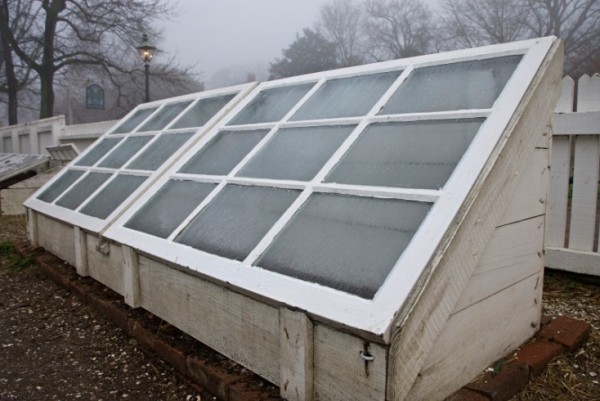 Now is the time of year to begin the production of vegetable transplants that will be ready to put into the garden in late March and early April.
Now is the time of year to begin the production of vegetable transplants that will be ready to put into the garden in late March and early April.
In preparation, we have gathered dung to supply the hotbed.
For those new to the management of hotbeds we turn to Mr. Abercrombie who wrote in 1778 “As horse-dung Hot-beds are of general utility in gardening, I propose to handle this article at some length, for the benefit of those unacquainted with their nature. The sort of horse-dung to be understood for the purpose of Hot-beds, is the dung and wet litter together, daily cleaned out of stables where horses always stand, and are littered down with plenty of straw every night, which being rendered wet by the urine and dung of those animals, composes the principal material for a dung Hot-bed; for the dung alone without litter would do nothing, but the litter being thus moistened, and cleared out along with the dung, are both mixed together.”
The difficulty for the modern hotbed gardener, including the gardeners at Colonial Williamsburg’s Historic Area, is that horses are almost always bedded in sawdust rather than straw today. Sawdust, in a quantity that can be conveniently collected, will not generate the heat needed for the hotbed and actually retards the heat of the manure.
Without the benefit of urine soaked straw, we use pure, fresh horse manure gathered from the pastures. This will provide an adequate heat for starting seedlings but will not maintain its heat for as long as manure and straw mix will.
In Williamsburg we start the first hotbed in January. As the dung must be gathered while it is relatively dry and not frozen, the gardener must not miss the opportunity when the weather is right.
As Mr. Abercrombie advises: “Observe that the dung must be fresh…for the newer the dung the better, its heat proving always the most effectual and durable, provided it is properly prepared. Therefore always chuse the fresh, or new-made steamy dung.”
After the dung is gathered it is piled in the orchard to form its first heat. Once it has reached the temperature of 160 degrees on Mr. Fahrenheit’s scale it is loaded into the hotbed pit. The glasses are then put on and the manure allowed to regain its heat.
Next week we will examine the laying on of soil and the planting of seeds.



Is there a reason that straw is not used today since it was the method used back in the 1700’s ??? Just curious…
Dearest Marie,
In the modern world sawdust is a cheaper, easier bedding material than is straw and because our horses are kept in a very modern stable facility, rather than in historic area stables, there is no incentive to bed them in straw which is very difficult to work with compared to sawdust. I did persuade the folks at our stables to bed a few of their horses in straw a couple of years as an ago as an experiment but because our stables are kept so scrupulously clean the resulting material was just not filthy enough to generate the proper heat. It seems to be yet another incidence in which 21st century livestock have it much better than did their 18th century ancestors. Good for the animals, bad for the hotbed. We do, occasionally, bed sheep in straw and I have tried mixing this in with the manure from the pastures with some success.
With every expectation of a steamy, though short lived, hotbed,
I remain, Yr. obedient servant,
Wesley Greene